Yanmar EF393T Operator's Manual

OPERATOR’S MANUAL
DIESEL TRACTOR
EF393T
en Original instructions
Downloaded from www.Manualslib.com manuals search engine
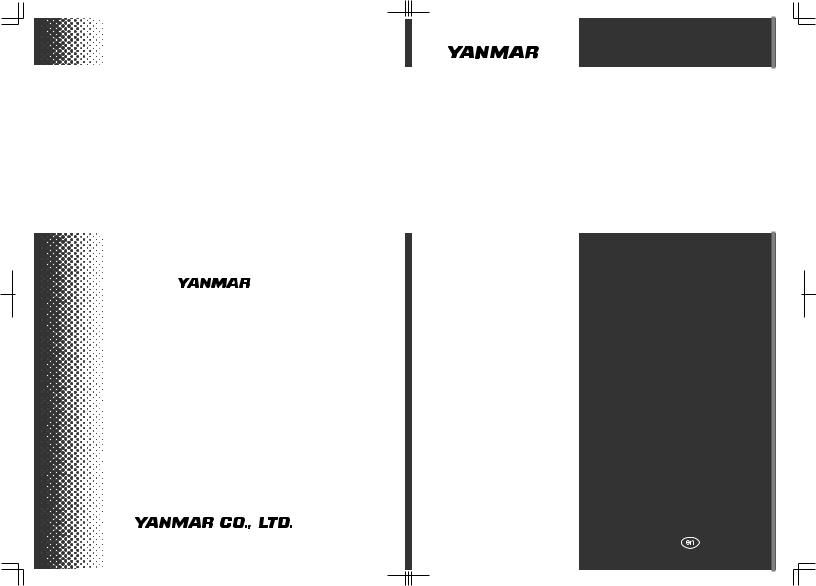
TRACTOR DIESEL
OPERATOR’S MANUAL
DIESEL TRACTOR
EF393T
0A041-ENXXXX
Oct. 2014
http://yanmar.com
Original instructions
Downloaded from www.Manualslib.com manuals search engine

SAFETY
Never attempt to operate or service this machine until you have first read and understood all of the applicable Safety Instructions that are set forth in this Manual.
The failure to comply with all relevant Safety Instructions could result in bodily injury.
EF393T OM
Downloaded from www.Manualslib.com manuals search engine

TO THE OWNER
This instruction manual describes how to maintain your tractor in good condition and how to operate it safely and correctly. Please read this manual carefully before using the tractor. Keep this manual close to your tractor, after you have read through it. If you lose or damage this manual, ask your YANMAR dealer for a new manual right away.
IMPROVEMENT
Sometimes parts are changed to improve or upgrade the features of the tractor, or for other reasons. Therefore, the parts shown in this manual may not apply to your tractor.
Note:
All data are subject to change without prior warning. Some illustrations and photographs may show optional accessories.
A Roll-over Protective Structure (ROPS) is optional.
SYMBOLS USED
1. Safety-alert Symbol
This is the safety-alert symbol. When you see this symbol on your tractor or in this manual, be alert to the possibility of personal injury and carefully read the messages that follow.
2. Signal Words
The signal words "DANGER" "WARNING" "CAUTION" are used with the safety-alert symbol.
(1)"DANGER" indicates an imminently hazardous situation which, if not avoided, will result in death or serious injury.
(2)"WARNING" indicates a potentially hazardous situation which, if not avoided, could result in death or serious injury.
(3)"CAUTION" indicates a potentially hazardous situation which, if not avoided, could result in minor or moderate injury.
3.Service instructions
(1)This stop symbol indicates important proper operation or service messages in this manual. When you see this symbol, carefully read the messages that follow.
(2)“NOTE” describe precautions to take while working.
4.Measurements
 IMPORTANT
IMPORTANT
NOTE
This tractor is of metric design. All hardware are therefore metric (ISO). Make sure to use the specified metric hardware when service becomes necessary.
5. Direction
Right-hand and Left-hand sides of the tractor are determined by facing in the direction of the tractor forward travel.
EF393T OM
Downloaded from www.Manualslib.com manuals search engine

TABLE OF CONTENTS
SAFETY INSTRUCTIONS |
|
1 |
|
AFTER SALES SERVICES |
|
15 |
|
|
|||
TRACTOR OUTLINE |
|
17 |
|
|
|||
PARTS NAMES |
|
18 |
|
|
|||
LABEL LOCATIONS |
|
19 |
|
|
|||
CONTROLS |
|
21 |
|
|
|||
OPERATIONS |
|
29 |
|
|
|||
1. |
Pre-operation checks |
|
29 |
2. |
Break-in (initial 50 hours) |
|
33 |
3. |
Before starting |
|
33 |
4. |
Start and stop |
|
34 |
4-1. Start and stop engine |
|
34 |
|
4-2. Start, gear shifting and stop tractor |
|
35 |
|
5. |
Driving on a road |
|
37 |
6. |
Driving on a slope |
|
38 |
7. |
Driving in and out of fields |
|
38 |
8. |
Setting adequate speed |
|
38 |
9. |
Turning in a field |
|
39 |
10. Differential gear lock |
|
39 |
|
11. |
Loading and unloading |
|
40 |
12. Wheel tread |
|
41 |
|
13. Hydraulic power take off |
|
42 |
|
14. Using 3-point hitch |
|
42 |
|
15. Drawbar hitch |
|
44 |
|
16. General precautions on attaching and |
|
44 |
|
|
detaching an implement |
|
|
17. Power steering |
|
45 |
|
18. Safety frame (ROPS) |
|
45 |
|
19. Tightening torque of bolts and nuts |
|
45 |
|
OPENING BONNET |
|
46 |
|
|
|||
AFTER OPERATION |
|
47 |
|
|
|||
EF393T OM
Downloaded from www.Manualslib.com manuals search engine
PERIODICAL SERVICE |
|
49 |
|
1. |
Check intervals |
|
49 |
2. |
Oil and grease |
|
50 |
3. |
Capacity of oil and water |
|
50 |
4. |
Equivalent oil to transmission fluid TF500 |
|
50 |
5. |
Fuel system |
|
51 |
|
5-1. Fuel and refill |
|
51 |
|
5-2. Drain and cleaning of water separator |
|
51 |
|
5-3. Replacing fuel filter (cartridge type) |
|
52 |
6. |
Oil and filter |
|
53 |
|
6-1. Engine oil and filter |
|
53 |
|
6-2. Transmission-hydraulic oil and filter |
|
54 |
|
6-3. Front axle oil |
|
55 |
7. |
Engine coolant |
|
56 |
8. |
Radiator screen |
|
57 |
9. |
Cleaning air cleaner element (dual element) |
|
57 |
10. Checking battery |
|
58 |
|
10-1 Check battery |
|
59 |
|
10-2. Removing and installing battery |
|
59 |
|
10-3. Charging battery |
|
60 |
|
11. |
Checking pipes and hoses |
|
60 |
12. Checking electric wires |
|
60 |
|
13. Greasing |
|
61 |
|
14. Adjusting brake pedal |
|
62 |
|
15. Adjusting clutch pedal |
|
62 |
|
16. Checking steering wheel |
|
63 |
|
17. Adjusting fan belt |
|
63 |
|
18. Checking and adjusting toe-in |
|
64 |
|
19. Replacing fuse |
|
64 |
|
19-1. Fuse box |
|
64 |
|
19-2. Slow blow fuse |
|
65 |
|
20. Checking tire and wheel |
|
65 |
|
21. Color of exhaust gas |
|
65 |
|
TROUBLESHOOTING |
|
66 |
|
|
|||
SPECIFICATIONS |
|
69 |
|
|
|||
IMPLEMENT CAPACITIES |
|
70 |
|
|
|||
EF393T OM
Downloaded from www.Manualslib.com manuals search engine
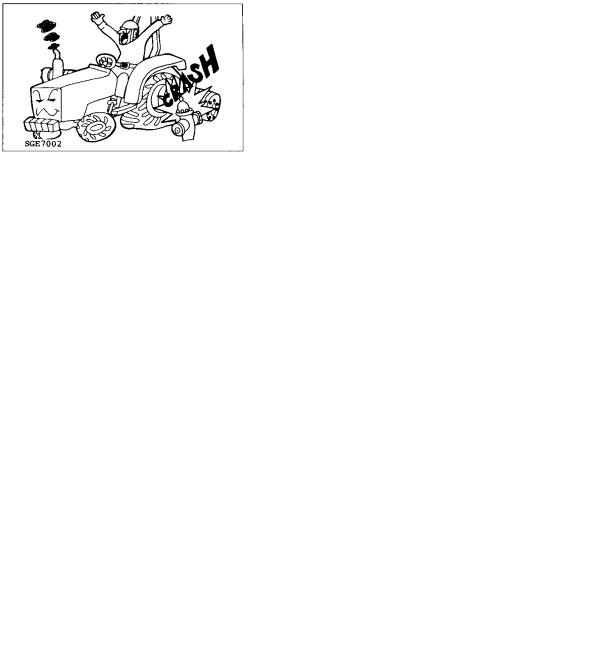
SAFETY INSTRUCTIONS
 DANGER
DANGER
Read these instructions carefully.
Important instructions are given for the safe operation and servicing of the tractor.
Failure to follow these instructions is likely to result in an accident involving death or serious injury.
STUDY THE TRACTOR AND
IMPLEMENTS
Do not permit anyone unfamiliar with the tractor or the operations of its implements to use the machine.
The operator’s manual should be considered a permanent part of the tractor and should remain with the tractor.
Know the positions and functions of all controls and the meaning of any identification symbols on your controls, gauges, and indicators before attempting to operate the tractor.
Know how to stop the engine in an emergency.
Make sure you understand the capabilities, operating characteristics and limitations of the tractor and implement, such as maximum ballast weight, hydraulic lifting capacity, speed, turning radius, operating clearances etc.
Do not add extra ballast weight to compensate for a load that is too heavy.
1 |
EF393T OM |
Downloaded from www.Manualslib.com manuals search engine

PROTECT OPERATOR SAFELY
Install an approved Roll-over Protective Structure (ROPS) for safe operation. If a tractor rolls over without a ROPS, death or serious injury is likely.
Always fasten the seat belt while operating the tractor with Roll-over Protective Structure (ROPS) up.
Do not use the seat belt if the foldable Roll-over Protective Structure (ROPS) is in the folded position or the tractor does not have the Roll-over Protective Structure (ROPS).
Extreme caution is required when operating a tractor around trees or other overhead obstructions, such as guy wires or power lines. Interference between the ROPS and these obstructions may cause the tractor to tip backwards.
Do not modify any structural portions of the ROPS by welding, bending, grinding or cutting them. If any component of the ROPS is damaged or involved in a rollover incident, replace it with a complete new cage. Do not attempt to repair the original one. Damaged or modified structural parts impair the strength of the ROPS and may lead to injury.
Avoid loose fitting or baggy clothing, torn clothing, bulging pockets, frayed edges or heavy cuffs. Loose frayed and bulky clothing can easily become entangled in rotating parts. Wear work clothes and work shoes or boots. Also you may need a: SAFETY HELMET,
SAFETY SHOES, EYE PROTECTION, HEAVY DUTY GLOVES, HEARING PROTECTION, REFLECTIVE CLOTHING, OR A RESPIRATOR/FILTER MASK.
Wear whatever safety gear and clothing is necessary for the job.
Prolonged exposure to loud noise can cause impairment or permanent loss of hearing. Wear a suitable hearing protective device such as ear protectors or earplugs to protect against objectionable or uncomfortable noise.
2
Downloaded from www.Manualslib.com manuals search engine
EF393T OM
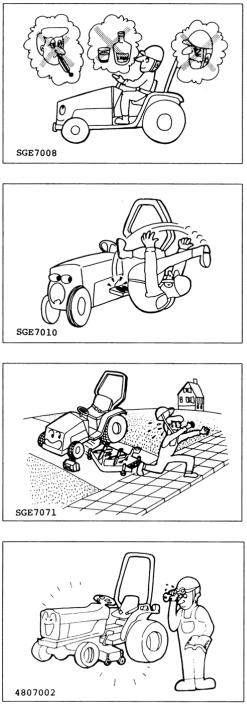
BEFORE OPERATING
Do not operate the tractor when tired, sick, sleepy, drunk, feeling overworked, taking medicine, pregnant, suffering from mental disease or if other improper conditions are present. These conditions impair a person’s skill and judgment. When you begin feeling tired while operating the tractor, take a 10-minute break to stretch, walk about, lie down or snack. Do not continue if you still feel tired after taking a break.
Remove oil, grease or mud from the hand rails, steps, pedals, controls, and floor to avoid slips or loss of control.
In winter, scrape off any ice or snow on the hand rails, steps, pedals, controls, and floor.
To attach or remove an implement, refer to the implement and tractor manufacturer’s manuals for the proper procedures.
To unhitch an implement, move to a level area, lower the implement to the ground and then block the equipment in position before unhitching. If an implement has wheels, block them to prevent it from rolling.
Make sure
(1)The tractor and implements are in good condition and properly adjusted.
(2)To check for loosened bolts, adequate lubricants, damaged or under-inflated tires, safety shields and devices, steering and braking linkages, hydraulic leaks, etc. Refer to this manual for more detailed information.
(3)That implements are properly attached and hooked up. Check that the PTO U-joint yoke and locking devices are securely latched on their shafts.
(4)That the tractor’s PTO speed matches the implement’s specifications.
3
Downloaded from www.Manualslib.com manuals search engine
EF393T OM
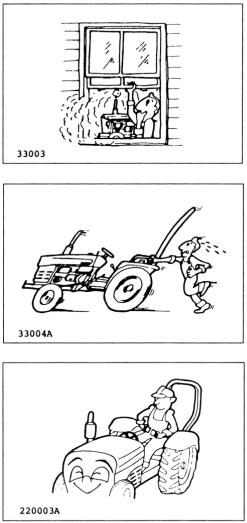
STARTING
START THE ENGINE SAFELY
If you operate the engine inside a closed building, be sure there is plenty of ventilation before starting the engine. Exhaust fumes are poisonous. Carbon monoxide is especially dangerous because it is odorless and colorless. You can easily be overcome without realizing it.
Always stay near the tractor and keep the parking brake set securely while warming it up.
Only start the engine from the operator’s seat. Never start the engine while standing on the ground.
Before you start the engine:
(1)Sit in the operator’s seat and adjust the seat position if necessary.
(2)Make sure the ROPS is in working condition and seat belt securely fastened.
(3)Lower any implement to the ground.
(4)Place speed shift lever and the PTO switch in neutral.
(5)Set the parking brake.
(6)Disengage the PTO for the neutral position.
(7)Check all the instruments, gauges and indicator lights.
(8)Be sure everyone is clear of the tractor and implement.
4
Downloaded from www.Manualslib.com manuals search engine
EF393T OM
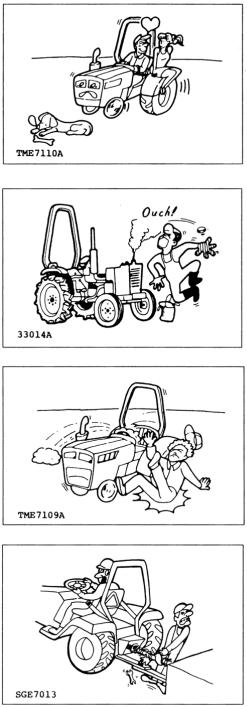
DURING OPERATION
OPERATE THE TRACTOR SAFELY
Keep people and pets a safe distance away when starting and operating the tractor and implement.
Do not permit any person other than the operator to ride or board the tractor or implements, including any wagons.
Do not play games with the tractor.
Never allow children to ride on your lap.
Do not touch the muffler, radiator, engine or other high temperature parts before they have cooled down completely.
Do not try to get on or off a moving tractor or implements. Always use the hand rails and steps and face the tractor when getting on and off.
Never use control levers as a hand hold and never step on foot controls when getting on and off.
Do not get on the tractor with wet or greasy hands, or muddy shoes. Do not jump off the tractor. Be aware of slippery conditions on the ground.
Make sure you check the connecting points on your equipment.
Keep hands, feet and clothing away from power-driven parts. Keep others away from articulated joints, hitches, drawbar, lift arms, PTO drives, cylinders, and anything else that moves.
Never stand, or allow anyone else to stand, between the tractor and an implement, unless the engine is turned off and the parking brake is engaged securely.
5 |
EF393T OM |
Downloaded from www.Manualslib.com manuals search engine
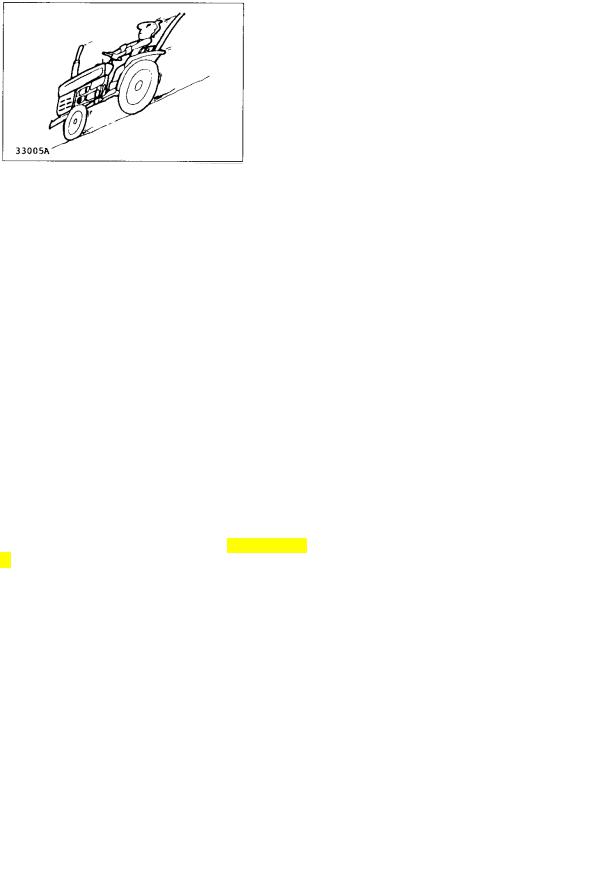
OPERATE THE TRACTOR SAFELY (continued)
Oversized implements are dangerous for tractor operation and are not safe for you. Refer to the implement’s operator manual for the minimum and maximum horsepower requirements and weights that are allowed.
When using a heavy implement in front, always install ballast or an implement on the rear for safe, stable steering control.
When using a heavy implement on a rear 3-point hitch, always install ballast or an implement on the front for safe, stable steering control.
Slow the tractor down when crossing rough ground, tall grass or weeds. Rocks, holes and stumps may be hidden in the brush.
Do not let your tractor bounce. You may lose steering control.
Never use the tractor to round up farm animals.
Do not allow the tractor to coast downhill with the clutch in, or with the gear shift in neutral.
When operating the tractor on a slope, set the wheel tread as wide as possible for maximum stability, reduce the engine speed and avoid quick application of the brakes or sharp turns.
Stay off hills and slopes which are too steep.
6
Downloaded from www.Manualslib.com manuals search engine
EF393T OM

AVOID TIPPING OVER
When starting the tractor on an uphill slope, shift to as low a gear as possible and reduce the engine speed to avoid tipping over backward.
Do not drive near the edge of a gully or a steep embankment. Avoid holes, ditches, etc. which may cause the tractor to tip over, especially on hillsides or steep slopes.
When operating on slopes or rough uneven ground, it is important to have as much distance as possible between the wheels. Operate the tractor carefully at the lowest speed.
Do not pull carts etc. from the top link or the top link hinge, rear axle, or any point above the drawbar. Doing so could cause the tractor to tip over backward. Only attach items to be pulled to the drawbar.
Use care when pulling loads or installing a heavy implement.
(1)Only use approved hitch points.
(2)Limit loads to those which you can control safely.
(3)Limit travel speeds so that you can control the tractor safely.
(4)Do not turn too quickly.
(5)Use care when backing up.
(6)Install the amount of ballast recommended in the operator’s manual.
Driving forward out of ditch or in muddy conditions, or up a steep slope, could cause the tractor to tip over backward. If the mud is deep enough it will keep the wheels from turning. Then, the tractor will rotate up and back around the axle very quickly. When stuck in muddy conditions, do not remove the implement or ballast weight. Always back out.
7
Downloaded from www.Manualslib.com manuals search engine
EF393T OM

STAY CLEAR OF THE PTO
The PTO shaft safety guard (A) should be installed when the PTO system is not in use.
Make sure that the tractor PTO speed matches the implement’s required PTO speed.
Do not drive or operate the implement beyond the tractor’s PTO speed.
Stop the engine and be sure the PTO has stopped moving before:
(1)Connecting or disconnecting the PTO shaft.
(2)Making any adjustment to the PTO drive or 3-point hitch.
(3)Adjusting, cleaning or servicing PTO driven implements.
8 |
EF393T OM |
Downloaded from www.Manualslib.com manuals search engine

TRANSPORTING
Raise all implements and place them in the locked-for-transport position.
Do not drive the tractor on the road with implements in motion.
Couple the brake pedals together for travel at road speeds. (This only applies to models with two brake pedals.)
Do not make sharp turns at road speeds.
Always dim your headlights when another vehicle is coming toward you. Keep the lights adjusted so that they will not blind the driver of another vehicle.
Before going down a steep hill, shift to the lowest speed in order to control tractor with the least braking possible. Do not coast downhill.
Do not stop or start suddenly when going uphill or downhill.
When loading (or unloading) the tractor onto a vehicle, use care as follows:
(1)Use a strong loading ramp or loading dock.
(2)Use the lowest reverse speed and drive up the loading ramp backward.
(3)Set the parking brake and place wheel blocks firmly under the vehicle’s wheels.
(4)Do not try to drive onto a trailer from the bank of a ditch.
Secure the tractor and any other load with chains. Be sure they are tight.
If chains are not available, use rope, wire, blocks, or a winch cable. Check the load after traveling a few kilometers, and every 100 km thereafter, to make sure that the ties are not coming loose. Also, check after rough bumps in the road.
9
Downloaded from www.Manualslib.com manuals search engine
EF393T OM

TOWING
When towing a load that weighs more than the tractor, the trailer should have its own brakes. When towing, drive slowly, avoid hills and apply the brakes gently.
A safety chain will help control an implement being pulled if it accidentally separates from the drawbar while traveling. Using appropriate adapter parts, attach the chain to the tractor drawbar support or to some other specified anchor location. Leave only enough slack in the chain to permit turning.
Do not tow the tractor faster than the tractor’s maximum travel speed in the highest gear, and never more than 25 km/h (16 mph).
Check local regulations concerning towing. Towing is illegal in some countries.
AFTER THE DAY’S OPERATION
PARK THE TRACTOR SAFELY
Park tractor on a firm level surface.
When parking the tractor, couple the brake pedals together and set the parking brake securely. When you must park on a slope, position the tractor at a right angle to the slope and set the parking brake securely. Then, block both the front and rear wheels.
Take all possible precautions as follows when leaving tractor unattended:
(1)Disengage the PTO and lower any implement to the ground.
(2)Move all shift levers to neutral.
(3)Couple the brake pedals together and set the parking brake lever.
(4)Run the engine for 2 to 3 minutes at one-third throttle speed and no load in order to cool it.
(5)Stop the engine and remove the key.
(6)Cycle the hydraulic controls to eliminate any residual pressure.
10
Downloaded from www.Manualslib.com manuals search engine
EF393T OM

MAINTENANCE AND SERVICE
AVOID EXPLOSIONS OR FIRES
Refuel the tractor when the engine is cool and in a well-ventilated area, preferably outside.
Never fill the fuel tank with the engine running.
Be sure to use the correct type and grade of fuel.
Keep all sparks, flames and smoking materials well away while handling fuel.
Ground the fuel funnel or nozzle against the filler neck on the tractor to prevent sparks.
Do not overfill the tank or spill the fuel. If fuel is spilled, wipe it up immediately. Install the fuel tank cap securely after refueling.
Be sure there is plenty of ventilation before charging the battery. Gas produced while charging the battery is explosive.
Keep all sparks, flames, and smoking materials well away from battery. Hydrogen gas at a concentration as low as 7 per cent can explode in the presence of a spark or open flame and spatter acid.
Use a flashlight to check the battery electrolyte level. Never use an open flame or match to check.
Keep the engine clean and free of grass, leaves, or excessive grease.
Let the engine cool down before storing the tractor in an enclosure or covering it with a sheet.
11 |
EF393T OM |
Downloaded from www.Manualslib.com manuals search engine

MAINTENANCE AND SERVICE (continued)
Do not service the tractor while it is in motion or while the engine is running.
Before servicing the tractor, always set the parking brake, block the wheels, lower the implement, release all hydraulic pressure and place all the controls in neutral.
Use only the correct tools and equipment.
Unauthorized modification to the tractor may impair its function, create an unsafe situation and reduce the tractor’s useful working life.
Do not use substitute parts that may not meet the strength and design requirements or may not fit the tractor.
Do not use repair parts not approved by YANMAR.
Remove the radiator cap only when the coolant temperature is low. Wait at least one hour after operation, to allow the coolant to cool down.
Cover the radiator cap with a cloth before opening it and release the pressure gradually before completely removing the cap.
Do not service the hydraulic system when the hydraulic oil is hot.
Do not set the relief valve pressure higher than stated in the tractor or implement specifications.
Do not close off the overflow or bypass lines.
12 |
EF393T OM |
Downloaded from www.Manualslib.com manuals search engine
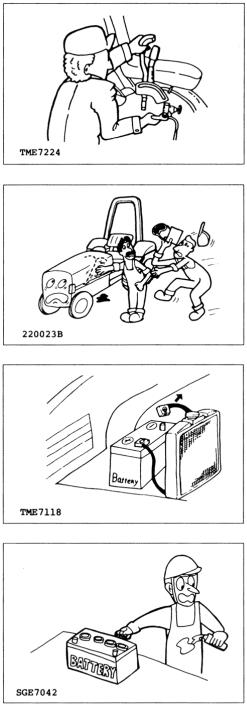
MAINTENANCE AND SERVICE (continued)
Hydraulic oil or diesel fuel escaping under pressure can penetrate the skin and cause serious injury. Before disconnecting any lines, be sure to relieve all pressure. Before applying pressure, be sure all connections are tight and all components are in good condition.
Fluid escaping under pressure from a very small hole can be almost invisible. Wear safety goggles for eye protection and use a piece of cardboard to check for suspected leaks. Do not use your hands. If injured by escaping fluid, see a doctor at once. Serious infections and other problems can develop if proper medical treatment is not administered immediately.
Disconnect the battery ground cable before working on the electrical system or working in any area where you might come into contact with electrical components. Disconnect the ground cable first and reconnect it last.
The sulfuric acid in a battery is poisonous. It can destroy clothing and burn the skin. Wear eye protection and rubber gloves when filling the battery. If you spill acid on yourself, flush your skin with water and apply baking soda or lime to neutralize the acid. Then seek medical attention right away. If acid is swallowed, get medical attention immediately!
13
Downloaded from www.Manualslib.com manuals search engine
EF393T OM

Storage
Whenever the tractor will not be used for a few months, do the following:
(1)Drain the fuel tank.
(2)Lower any implement still attached.
(3)Set the parking brake and block the wheels.
(4)Remove the battery and store it in a cool, dry place, out of the reach of children.
 CAUTION
CAUTION
ALWAYS BE ENVIRONMENTALLY
RESPONSIBLE
Follow the guidelines of the governmental agency for the proper disposal of hazardous materials such as engine oil, diesel fuel, engine coolant and, machine fluid, grease.
NEVER dispose of hazardous materials irresponsibly by dumping them into a sewer, on the ground, or into groundwater or waterways.
Failure to follow these procedures may seriously harm the environment.
Comply with legal regulations and guidelines for disposal of: empty containers for fuel, cooling water (coolant), oil, grease; fuel/oil filters; batteries; machine itself; machine accessories; and packaging materials.
14
Downloaded from www.Manualslib.com manuals search engine
EF393T OM

AFTER SALES SERVICES
After sales services
When your tractor is not working normally, check it referring to the troubleshooting section. You can of course consult with your service representative.
Whenever you ask service to your service representative, following information are very helpful to identify your tractor.
1)The label of tractor model name and serial number
(A)is on the left rear fender and the stamp of the serial number (B) is on right side of front frame.
2)Engine model name and serial number (C).
3)Hour-meter (D) shows estimated hours of operation. Turn on key switch to read hours.
4)Operating conditions.
Kind of work and implement used when a problem is happened.
5)Any other information when a trouble is occurred. Noise, vibration, function etc.
Availability of spare parts
Maintenance parts or spare parts are available for 10 years after the production of this tractor series has been discontinued. However, special parts will be subject to consultation. Yanmar may be able to supply a particular part after the normal supplying period.
15
Downloaded from www.Manualslib.com manuals search engine
(A) Tractor model name & serial number
(B) Tractor serial number
(C) Engine model name & serial number
EF393T OM

 WARNING
WARNING
Do not move the tractor if the wheel mounting bolts or nuts are loose. If the tractor is driven with loose nuts or bolts, there is a possibility that an accident will occur.
Make daily and periodic wheel inspections to check for loose nuts and bolts on the wheels. If they are loose, retighten them to the specified torque.
 IMPORTANT
IMPORTANT
The first 50 hours of handling and maintenance greatly affect the service life and performance of a new tractor. In particular, pay special attention to the following points during this period of time.
(1)Refrain from sudden acceleration and sudden braking.
(2)Do not increase the speed too much or carry any more load than is necessary.
(3)Operate the tractor only after the engine has warmed up sufficiently.
(4)Slow down on a rough road or on a slope.
(5)Check the tightness of the wheel mounting bolts after the first 10 hours and again after the first 50 hours. If they are loose, retighten them. (For specific tightening torques, refer to the table in the instruction manual.)
 IMPORTANT
IMPORTANT
When the tractor gets stuck in a muddy portion in field, do not tie a piece of lumber, log or pipe to the front or rear wheels to drive out of the muddy portion.
It may break transmission and/or rear axle inner parts or cases.
Put a ladder bridge under the wheels and then drive out. Or use strong rope or chain to pull it out of the muddy portion slowly by the other tractor or so.
Note:
These photos show rear tire with cage wheel.
16 |
EF393T OM |
Downloaded from www.Manualslib.com manuals search engine
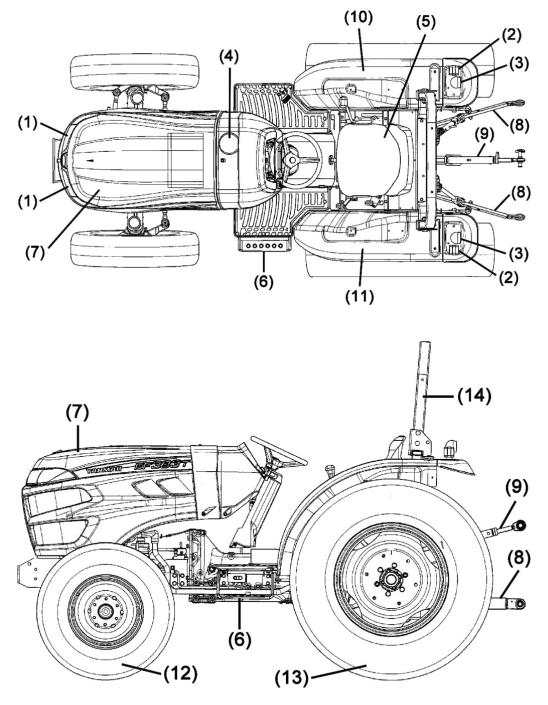
TRACTOR OUTLINE
(1) |
Head light |
(8) |
Lower link |
(2) |
Turn signal lamp |
(9) |
Top link |
(3) |
Tail lamp |
(10) |
Fender, R |
(4) |
Fuel refill port |
(11) |
Fender, L |
(5) |
Operator’s seat |
(12) |
Front tire |
(6) |
Sub-step |
(13) |
Rear tire |
(7) |
Bonnet |
(14) |
ROPS (Safety frame) |
17 |
EF393T OM |
Downloaded from www.Manualslib.com manuals search engine
